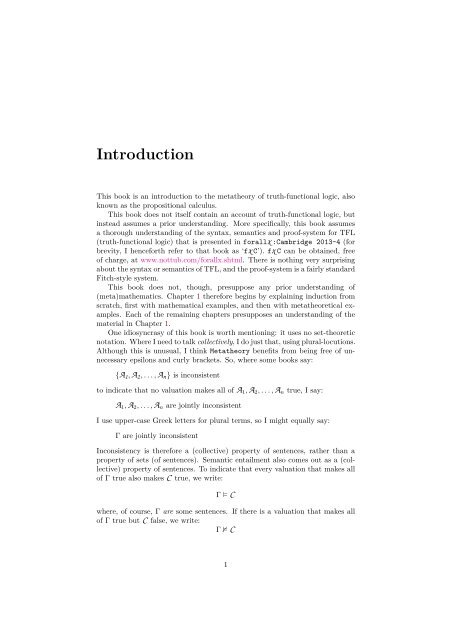Metatheory - University of Cambridge
Metatheory - University of Cambridge
Metatheory - University of Cambridge
You also want an ePaper? Increase the reach of your titles
YUMPU automatically turns print PDFs into web optimized ePapers that Google loves.
Introduction<br />
This book is an introduction to the metatheory <strong>of</strong> truth-functional logic, also<br />
known as the propositional calculus.<br />
This book does not itself contain an account <strong>of</strong> truth-functional logic, but<br />
instead assumes a prior understanding. More specifically, this book assumes<br />
a thorough understanding <strong>of</strong> the syntax, semantics and pro<strong>of</strong>-system for TFL<br />
(truth-functional logic) that is presented in forallx :<strong>Cambridge</strong> 2013-4 (for<br />
brevity, I henceforth refer to that book as ‘fx C’). fx C can be obtained, free<br />
<strong>of</strong> charge, at www.nottub.com/forallx.shtml. There is nothing very surprising<br />
about the syntax or semantics <strong>of</strong> TFL, and the pro<strong>of</strong>-system is a fairly standard<br />
Fitch-style system.<br />
This book does not, though, presuppose any prior understanding <strong>of</strong><br />
(meta)mathematics. Chapter 1 therefore begins by explaining induction from<br />
scratch, first with mathematical examples, and then with metatheoretical examples.<br />
Each <strong>of</strong> the remaining chapters presupposes an understanding <strong>of</strong> the<br />
material in Chapter 1.<br />
One idiosyncrasy <strong>of</strong> this book is worth mentioning: it uses no set-theoretic<br />
notation. Where I need to talk collectively, I do just that, using plural-locutions.<br />
Although this is unusual, I think <strong>Metatheory</strong> benefits from being free <strong>of</strong> unnecessary<br />
epsilons and curly brackets. So, where some books say:<br />
{A 1 , A 2 , . . . , A n } is inconsistent<br />
to indicate that no valuation makes all <strong>of</strong> A 1 , A 2 , . . . , A n true, I say:<br />
A 1 , A 2 , . . . , A n are jointly inconsistent<br />
I use upper-case Greek letters for plural terms, so I might equally say:<br />
Γ are jointly inconsistent<br />
Inconsistency is therefore a (collective) property <strong>of</strong> sentences, rather than a<br />
property <strong>of</strong> sets (<strong>of</strong> sentences). Semantic entailment also comes out as a (collective)<br />
property <strong>of</strong> sentences. To indicate that every valuation that makes all<br />
<strong>of</strong> Γ true also makes C true, we write:<br />
Γ ⊨ C<br />
where, <strong>of</strong> course, Γ are some sentences. If there is a valuation that makes all<br />
<strong>of</strong> Γ true but C false, we write:<br />
Γ ⊭ C<br />
1
















